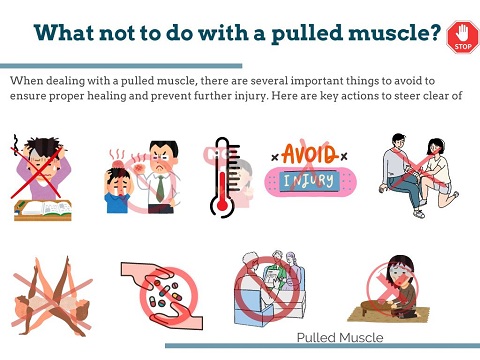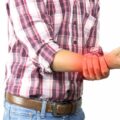Understanding common injuries like pulled muscles is crucial for maintaining overall physical health and wellness. These injuries can occur during various activities, from sports and exercise to everyday movements. In this article, we’ll explore the concept of pulled muscles, including their definition, causes, symptoms, and treatment options, to help you better understand and manage this type of injury.
What is a pulled muscle?
A pulled muscle, also known as a muscle strain or muscle tear, refers to an injury involving the stretching or tearing of muscle fibers and surrounding connective tissues. This injury commonly occurs due to sudden or excessive exertion, overuse, improper lifting techniques, or inadequate warm-up before physical activity. Pulled muscles can affect any muscle in the body but often occur in the back, neck, shoulders, thighs, or calves. Symptoms may include pain, swelling, bruising, stiffness, and limited range of motion in the affected area. Treatment typically involves rest, ice, compression, elevation (RICE), pain management, and gentle stretching exercises to promote healing and prevent further injury.
Causes of Pulled Muscles
Several factors can contribute to muscle strains, including:
- Overuse: Repetitive motion or overuse of a muscle group.
- Improper Technique: Poor form during physical activities.
- Lack of Warm-Up: Inadequate warm-up before exercise.
- Muscle Imbalance: Uneven strength between muscle groups.
Types of Muscle Strains:
Here are details on the types of muscle strains:
Grade 1 Muscle Strain (Mild):
- A Grade 1 muscle strain is considered mild and involves minimal damage to muscle fibers.
- Symptoms may include slight discomfort, tenderness, and mild swelling in the affected area.
- Range of motion is generally not significantly impacted, and there may be minimal or no loss of function.
- Recovery time is usually shorter, ranging from a few days to a couple of weeks with appropriate rest and conservative treatment.
Grade 2 Muscle Strain (Moderate):
- A Grade 2 muscle strain is more severe than Grade 1 and involves partial tearing of muscle fibers.
- Symptoms may include moderate to severe pain, swelling, bruising, and tenderness in the affected muscle.
- There may be noticeable limitations in range of motion, strength, and function, making daily activities challenging.
- Recovery time for a Grade 2 strain is typically longer, ranging from several weeks to a few months, depending on the extent of the injury and adherence to treatment.
Grade 3 Muscle Strain (Severe):
- A Grade 3 muscle strain is the most severe and involves complete tearing or rupture of muscle fibers.
- Symptoms are usually intense and may include severe pain, swelling, bruising, and tenderness, often accompanied by a visible deformity or gap in the muscle.
- Significant loss of function and mobility is common, with an inability to bear weight or use the affected muscle effectively.
- Recovery from a Grade 3 strain can be prolonged, requiring several months of intensive treatment, including rest, rehabilitation, and possibly surgical intervention to repair the damaged muscle tissue.
Acute Muscle Strain:
- An acute muscle strain occurs suddenly and is often the result of a traumatic event or forceful movement, such as lifting a heavy object or sudden acceleration during sports.
- Symptoms typically develop immediately or shortly after the injury and may range from mild to severe, depending on the extent of damage to the muscle fibers.
- Treatment for an acute muscle strain involves immediate first aid measures, followed by rest, ice, compression, elevation (RICE), and medical evaluation to determine the severity of the injury and appropriate management.
Chronic Muscle Strain:
- A chronic muscle strain develops gradually over time due to repetitive or overuse activities, such as repetitive lifting, running, or poor posture.
- Symptoms of chronic muscle strain may be subtle initially but worsen over time with continued activity, leading to persistent pain, stiffness, and weakness in the affected muscle.
- Treatment for chronic muscle strain focuses on identifying and addressing underlying factors contributing to the injury, such as ergonomic issues, muscle imbalances, or overtraining, along with targeted rehabilitation exercises to strengthen and restore function to the affected muscle group.
Understanding the different types of muscle strains and their characteristics can help individuals better recognize and manage these common injuries, facilitating optimal recovery and preventing complications.
Symptoms of a Pulled Muscle:
Here are detailed symptoms of a pulled muscle:
Pain:
Pain is the most common symptom of a pulled muscle. The pain may vary in intensity depending on the severity of the injury. It can range from mild discomfort to sharp, stabbing pain. The pain is typically localized to the area of the muscle that has been strained.
Swelling:
Swelling often accompanies a pulled muscle. The affected area may appear swollen or inflamed due to the body’s inflammatory response to the injury. Swelling may be noticeable immediately after the injury or may develop gradually over time.
Bruising:
Bruising, or discoloration of the skin, may occur as a result of bleeding beneath the skin’s surface. This can cause the skin to appear red, purple, or blue in the area surrounding the pulled muscle. Bruising may not always be present, especially in milder cases of muscle strain.
Tenderness:
The affected muscle may be tender to the touch. Gentle pressure applied to the area may elicit discomfort or pain. Tenderness may also be present when moving the affected muscle or joint.
Stiffness:
Stiffness or reduced range of motion is common with a pulled muscle. The injured muscle may feel tight or stiff, making it difficult to move the affected limb or joint. Stiffness may worsen with rest and improve with gentle movement and stretching.
Weakness:
Weakness in the affected muscle or limb is another symptom of a pulled muscle. The injured muscle may feel weak or unable to bear weight or resist force as effectively as usual. This can impact daily activities and functional movements.
Muscle Spasms:
In some cases, muscle spasms may occur as a result of a pulled muscle. Muscle spasms are involuntary contractions of the muscle fibers and can cause sudden, sharp pain and temporary loss of function in the affected area.
Difficulty Moving:
Individuals with a pulled muscle may experience difficulty moving the affected limb or joint. Movements that involve the injured muscle may be painful or limited, leading to functional impairment and reduced mobility.
Warmth:
The affected area may feel warm to the touch due to increased blood flow and inflammation associated with the injury. This warmth may be noticeable immediately after the injury and may persist as the body’s healing response continues.
Visible Deformity:
In severe cases of muscle strain, a visible deformity or bulge may be present in the affected muscle. This can indicate a more significant tear or rupture of the muscle fibers and may require medical attention.
It’s essential to seek medical evaluation if you experience severe or persistent symptoms of a pulled muscle, as they may indicate a more severe injury or underlying medical condition.
What not to do with a pulled muscle?
When dealing with a pulled muscle, there are several important things to avoid to ensure proper healing and prevent further injury. Here are key actions to steer clear of:

Avoid Continuing the Activity
- Do Not Push Through Pain
- Continuing to use the injured muscle can worsen the strain and delay recovery.
- Stop any activity that caused the injury immediately.
Avoid Ignoring the Pain
- Do Not Dismiss Pain Signals
- Pain is an indicator that something is wrong; ignoring it can lead to more serious injuries.
- Address the pain promptly with appropriate rest and treatment.
Avoid Heat in the Initial Stages
- Do Not Apply Heat Right Away
- Applying heat in the first 48 hours can increase swelling and inflammation.
- Use ice packs instead to reduce swelling and numb the pain.
Avoid Massaging the Injured Area
- Do Not Massage Immediately After Injury
- Massaging a freshly pulled muscle can increase inflammation and damage.
- Allow the initial inflammation to subside before considering gentle massages as part of rehabilitation.
Avoid Overstretching
- Do Not Stretch Aggressively
- Overstretching can exacerbate the injury and slow down the healing process.
- Stick to gentle stretches only after the acute phase has passed and under the guidance of a healthcare professional.
Avoid Returning to Activities Too Soon
- Do Not Resume Activities Prematurely
- Returning to sports or physical activities too quickly can lead to re-injury.
- Ensure the muscle has adequately healed before resuming normal activities.
Avoid Self-Medication Without Guidance
- Do Not Overuse Painkillers
- Over-reliance on pain medications can mask symptoms and potentially lead to improper healing.
- Use medications as directed and consult a healthcare provider for a proper treatment plan.
Avoid Skipping Rehabilitation
- Do Not Ignore Physical Therapy
- Skipping prescribed rehabilitation exercises can result in incomplete healing and decreased muscle function.
- Follow through with all recommended therapy sessions and exercises.
Avoid Poor Nutrition and Hydration
- Do Not Neglect Proper Nutrition
- Inadequate nutrition can hinder the healing process.
- Maintain a balanced diet rich in proteins, vitamins, and minerals to support muscle repair.
Avoid Inactivity After the Initial Rest Period
- Do Not Stay Immobile for Too Long
- Prolonged inactivity can lead to stiffness and weakened muscles.
- Begin gentle movements and exercises as soon as it is safe to do so.
By avoiding these common mistakes, you can help ensure a smoother and faster recovery from a pulled muscle. Always consult a healthcare professional for personalized advice and treatment recommendations.
Prevention of Pulled Muscles
Preventing muscle strains involves adopting healthy practices, such as:
- Proper Warm-Up: Warm up thoroughly before physical activities.
- Strength Training: Regular strength exercises to enhance muscle resilience.
- Flexibility Exercises: Incorporate stretching into your routine.
- Hydration: Stay hydrated to maintain muscle function.
Is there a difference between a pulled muscle and a strained muscle?

A pulled muscle and a strained muscle refer to the same condition. Both terms describe an injury where muscle fibers are overstretched or torn due to excessive force or stress. This injury can occur in any muscle and is commonly associated with physical activities that involve sudden movements or heavy lifting.
Key Points:
- Pulled Muscle: This term is more commonly used in everyday language.
- Strained Muscle: This is the more technical term used in medical contexts.
In both cases, the symptoms, causes, and treatments are identical. The terms are interchangeable and describe the same type of muscle injury.
FAQs about Pulled Muscle
A pulled muscle is usually identified by sudden pain during activity, followed by soreness, limited range of motion, bruising, or swelling in the affected area.
If walking doesn’t exacerbate the pain, light walking is acceptable. However, it’s important to avoid strenuous activity that could worsen the injury.
Lean proteins, dairy, nuts, legumes, whole grains, fruits, and vegetables.
Adequate rest, nutrition, hydration, and targeted rehabilitation exercises.
Consistent strength training, progressive overload, proper form, rest, and recovery.
Overnight gains aren’t realistic; focus on long-term, sustainable strength training and recovery.
Strength train regularly, eat a balanced diet, stay hydrated, get enough sleep, and manage stress.
Conclusion:
The healing time for a pulled muscle varies significantly based on the severity of the injury, the specific muscle affected, and individual factors such as age and overall health. Mild strains may heal within 1 to 3 weeks, moderate strains typically take 3 to 6 weeks, and severe strains can take several months to recover fully. Proper rest, treatment, and rehabilitation are crucial for a successful recovery. Always consult a healthcare professional if you experience persistent symptoms or if you are unsure about the severity of your injury.





